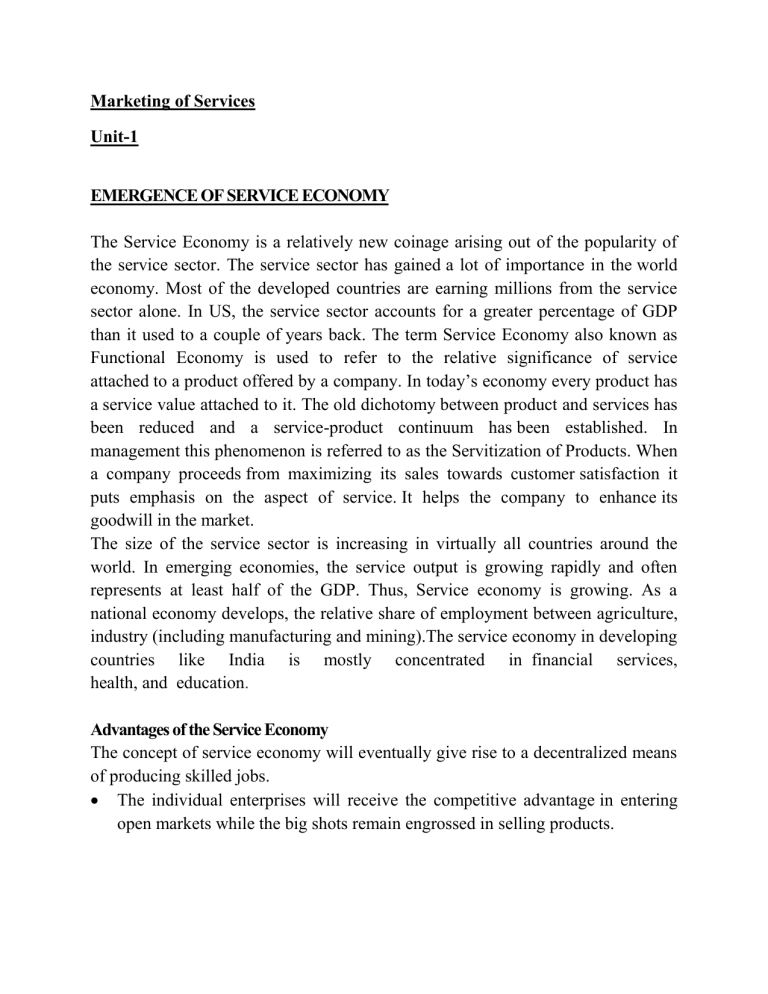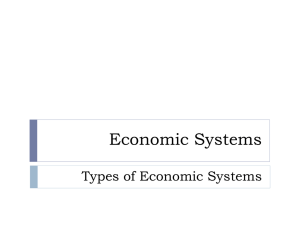
Marketing of Services Unit-1 EMERGENCE OF SERVICE ECONOMY The Service Economy is a relatively new coinage arising out of the popularity of the service sector. The service sector has gained a lot of importance in the world economy. Most of the developed countries are earning millions from the service sector alone. In US, the service sector accounts for a greater percentage of GDP than it used to a couple of years back. The term Service Economy also known as Functional Economy is used to refer to the relative significance of service attached to a product offered by a company. In today’s economy every product has a service value attached to it. The old dichotomy between product and services has been reduced and a service-product continuum has been established. In management this phenomenon is referred to as the Servitization of Products. When a company proceeds from maximizing its sales towards customer satisfaction it puts emphasis on the aspect of service. It helps the company to enhance its goodwill in the market. The size of the service sector is increasing in virtually all countries around the world. In emerging economies, the service output is growing rapidly and often represents at least half of the GDP. Thus, Service economy is growing. As a national economy develops, the relative share of employment between agriculture, industry (including manufacturing and mining).The service economy in developing countries like India is mostly concentrated in financial services, health, and education. Advantages of the Service Economy The concept of service economy will eventually give rise to a decentralized means of producing skilled jobs. The individual enterprises will receive the competitive advantage in entering open markets while the big shots remain engrossed in selling products. Product-life extension is a scheme that will reduce the material and energy consumption required to satisfy the needs of the consumers. It will enhance the productivity per unit. The enhancement in resource productivity is eventually transformed into competency and profitability. IBM is an unique example. In spite of being a manufacturing company it tends to call itself a services company. This has been the scenario since it realized that the price elasticity of demand for business solutions is less elastic than for hardware. The company now benefits from the revenue of the elongated contracts rather than receiving payment in a single mode FACTORS CONTRIBUTING TO THE GROWTH OF SERVICE SECTOR 1. GOVERNMENT POLICIES: It is Govt. which makes mandatory for price levels, distribution strategies, defining procedure attributes. Another important action taken by the Government’s “Privatization” means the policy of transform companies. The transformation of such operations like telecoms, airlines has led to restructuring cost cutting and more market focused. PROS OF PRIVATIZATION: Increase the efficiency Increase in profits New change will require services firm to change their marketing strategy, operational procedures, and HR policies. 2. SOCIAL CHANGES: Now a day there is a drastic change, two members are working, which requires to hire individuals to perform tasks that used to be performed by a house hold member. E.g. Child care, Laundry, Food preparation Combinations of changing life styles like:Higher income, declining prices for many high technology products –made for people to buy computers, Mobile phone etc. 3. BUSINESS TRENDS: Many professional associations have been forced by Govt. to remove long-standing bars on adv and promotional activities. Franchising has become wider spread in many service industries. Licensing of independent entrepreneurs to produce and sell a branded service according to tightly specified procedures. 4. ADVANCES IN IT: Changes come from the integration of computers and telecommunication.More powerful software enables firm to create databases that combine information about customers with details of all their transaction, so that they can be used to predict new trends, segment the market, new marketing opportunities. The creation of wireless networks and transfer of electronic equipments such as cell phones to lap tops and scanners, to allow sales and customer service personnel to keep in touch. 5. INTERNATIONALISATION AND GLOBALIZATION: A strategy of international expansion may be driven by a sector for new markets or by the need to respond to existing customers who are traveling abroad in greater numbers. When companies set up operations in other countries they often prefer to deal with just a few international suppliers rather than numerous local firms. The net effect is to increase competition and to encourage the transfer of innovation in both products and processes from country to country. Managerial challenges of Service sector/service business/ Service Company Service operations managers face many hurdles daily. They must ensure that the service is delivered according to the agreed-upon standards while meeting the customer’s needs. Additionally, they need to motivate employees to provide excellent service and meet targets. They also need to monitor and improve the quality of the service continuously. Some of the challenges faced by service operations managers include: Interacting with various departments that are frequently not in the office Ensuring that all parties have easy access to essential information and data Providing feedback and updates in real-time Capturing and reporting on metrics around the teams they support Creating long-term, efficient working procedures to improve performance









